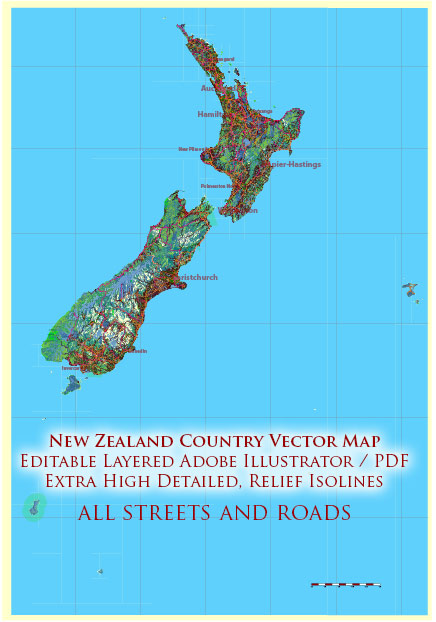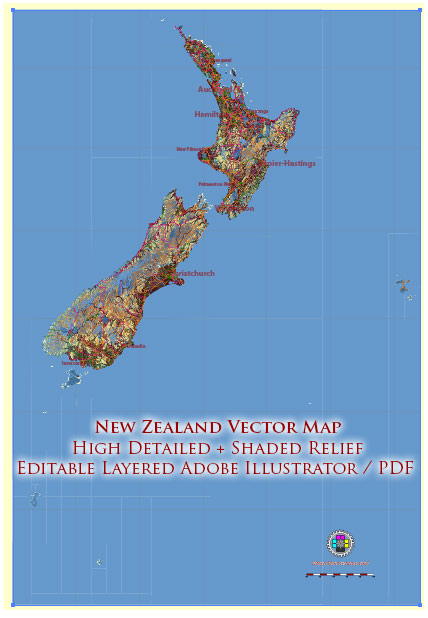New Zealand has a well-developed transportation and port infrastructure that supports the country’s economy and facilitates both domestic and international trade.
Vectormap.Net provide you with the most accurate and up-to-date vector maps in Adobe Illustrator, PDF and other formats, designed for editing and printing. Please read the vector map descriptions carefully.
Here’s a detailed overview of transportation and port infrastructure in New Zealand:
Transportation Infrastructure:
- Roads:
- New Zealand has an extensive road network that connects cities, towns, and rural areas.
- State Highways, managed by the New Zealand Transport Agency (NZTA), form the backbone of the road system.
- The road infrastructure includes bridges and tunnels, and improvements are continually made to enhance safety and efficiency.
- Railways:
- KiwiRail is the state-owned rail operator, managing both freight and passenger services.
- The rail network is crucial for transporting goods, especially bulk commodities, across the country.
- Passenger rail services are limited compared to freight, with the main focus on key routes.
- Air Transport:
- New Zealand has several international and domestic airports, with Auckland, Wellington, and Christchurch being the major international gateways.
- Domestic flights connect cities and towns, making air travel an essential mode of transportation within the country.
- Maritime Transport:
- Coastal shipping plays a significant role in transporting goods between ports around New Zealand.
- Interislander and Bluebridge are major ferry operators connecting the North and South Islands across the Cook Strait.
Port Infrastructure:
- Major Ports:
- Auckland, Wellington, Christchurch (Lyttelton), Tauranga, and Dunedin are among the major ports in New Zealand.
- Ports of Auckland is the largest container port, handling a substantial portion of the country’s imports and exports.
- Container Handling:
- Ports are equipped with container terminals with modern container-handling facilities.
- Tauranga is known for having one of the most efficient container terminals in the Southern Hemisphere.
- Bulk Cargo and Specialized Terminals:
- Ports handle various types of cargo, including bulk commodities like logs, dairy products, and minerals.
- Specialized terminals cater to specific industries, such as forestry, agriculture, and oil/gas.
- Infrastructure Investments:
- Ongoing investments are made to enhance port infrastructure, including the development of new terminals and upgrading existing facilities.
- These investments aim to improve efficiency, increase capacity, and accommodate larger vessels.
- Regulation and Governance:
- Port operations are subject to regulatory oversight, and port authorities work closely with government agencies to ensure compliance with safety and environmental standards.
- Technology Integration:
- Ports in New Zealand have been adopting technology to improve operations, such as automated container handling systems and digital tracking of cargo.
It’s important to check the latest sources or official websites for updates on New Zealand’s transportation and port infrastructure, as developments and investments may have occurred since my last update.



 Author: Kirill Shrayber, Ph.D.
Author: Kirill Shrayber, Ph.D.